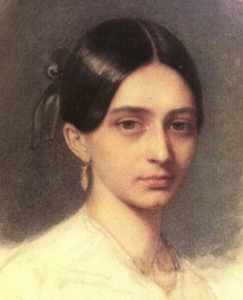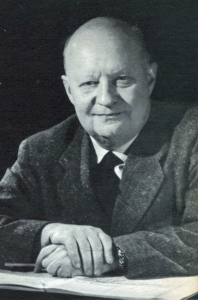- Moonlight my ass!
- The HUMBLER
- Who’s the top-selling pianist in history?
- Fly Away :(
- The Mozarts of Hair Metal
- How To Compose Today
- What time is it?
- Twins separated at birth
- To hear the world in a single note and heaven in a triad
- RIP Elliott Carter, Maestro of Thorny Complexity
- Monster Mashup
- May the best man wi… Oh, damn!
- Music for driving into trees: Sweet Wine
- Music for driving into trees
- My Favorite Things
- Mammas Please Let Your Babies Grow Up to Play Cowbells
- Claret for Clara
- Last of the Bohemians
- Guy walks into a bar
- How to break a heart with one chord
- What are oboes good for?
- Doppelganger
- Enigma

Claret for Clara
September 13, 2012
How delightful is it that Google is celebrating trailblazer Clara Schumann today! If she were alive today — at a perky 193 — how her heart would light up to hear all the adventurous women composers and performers of our generation.
In her day, Chopin and Liszt got all the press, but Clara was a renowned lioness at the keys.
Not only was she a fine composer in her own right; she was also muse to two Giants of Romanticism: husband Robert and lifetime love Brahms, both of who she supported artistically and financially. (Make of this what you will, but disconsolate Brahms shuffled off his mortal coil less than a year after Clara passed away.)
So… decant some Claret and raise a glass to Clara.
Categories: Composers, Brahms, Chopin, Clara Schumann, Robert Schumann

Guy walks into a bar
July 28, 2012
Guy walks into a bar with his schnauzer. Bartender says, “You can’t bring a dog into this bar.
But the guy says, “No, this is a special dog; he can talk. Check it out; ask him a question.”
Bartender is dubious, but then he asks the dog, “OK, whatdya call the outside of a tree?”
“Bark!” the dog answers.
“Hmm,” the bartender says.
“OK, ask him another question,” the guy says.
“Alright,” the bartender says, “What do you call the top of a house?”
“Roof!” replies the dog.
The bartender isn’t convinced. “Well, ask something harder,” the guy with the dog says, “more intellectual.”
“OK,” says the bartender, “but one more answer like that and you’re out of here. Let’s see... Who is the greatest German composer of the twentieth century?”
The dog thinks for a minute, then answers, “Orff!”
“All right, that’s it!” Says the bartender. Take that mangy mutt and scram!”
Guy picks up his dog and, as they leave, the dog turns back to the bartender and says, “What, you think it’s Hindemith?”

It's that second chord
How to break a heart with one chord
November 16, 2010
Chopin’s Waltz in c# minor, Opus 64, #2
Chopin was a master of extracting the profound sorrows of the heart out a single chord. In this waltz, it's that second chord.
On one hand, technically, it's a chromatic downward slipslide — it had to be downward, right? — of that minor sixth interval underpinned by — OMG! — a modulation! and we're only in the first full measure! Where’s he taking us? Well (still technically), to the seventh-saturated dominant of the dominant; not a Mozartian drive down a country lane, but a careening off the road into a sunless ravine, all with one chord, that second chord.
On the other hand, all theory aside... it's heartbreak.

Twins separated at birth?
Doppelganger
March 01, 2010
It's Doppelganger Week, when folks swaps faces for faces. Got me wondering: How about Doppelganger music?
Try this out: Play Chopin’s G Minor Ballade. Then before you exhale, put on Santana’s Europa.
For me, these two pieces are spiritual twins. I’ll try to make the case.
● They take you on the same ride. Slow and soulful at the start, the water breaks, then breathless crazed fury at the end. In a double-blind placebo-based randomized trial of listeners, cardiologists have measured the difference in heart rate between start and finish. In both instances, an increase on 45 beats per minute.
● The ride starts the same. An upward arching four-note minor-key phrase, a plea to the heavens, coming to rest on sustained notes that serve only as question marks hanging in the air.
● The ride continues along the same line. That initial phrase is sequenced a few times, adding to the pain and tension. And so it goes till near the end, when…
● All hell breaks out. The lions’ cages unlocked a feeding time. Skiing off a cliff. Freefall frenzy. Unfettered exhuberance. Full-tilt freakout.
But these parallels don’t really make the case. It’s more than the expressive arc. More than the heart-piercing harmonic and melodic language.
For me, these two pieces were drawn from the emotional well, inspired by the same muse, and tell the same story, whatever that might be. So all this half-diminished case-making is a musicologic fool’s game. Why are the Ballade and Europa dopplegangers? Because I feel it.
Next time: First movement of Beethoven’s Emperor Concerto and Hendrix’s House Burning Down.
So… What are your musical dopplegangers?
Oh… and happy 200th birthday, Piano Man.
Categories: Composers, Chopin, Musicians, Santana, Unified theory of music
Enigma
January 27, 2010
Quiz: What do Pachelbel’s Canon, Vivaldi’s Four Season, and Mahler’s Titan and Schubert’s Unfinished Symphonies have in common?
Answer: Last year, they were all voted by the listeners of the New York area’s sole classical station, WQXR, less popular than Edward Elgar’s Enigma Variations.
Huh? Elgar? Enigma?
Elgar? Mr Pomp and Circumstance? That veritable inventor of high school graduation? That doughty (yet self-doubting), late-blooming, paint-within-the-lines blue-blood Brit?
OK, granted, these 14 variations come comfortably to our urbane aural palate. But that’s not what’s so interesting. What’s so interesting is the treasure hunt — what the esteemed Sir Edward himself referred to as the hidden theme.
For the past 111 years, scholars, casual listeners, Dungeons and Dragons dorks and puzzle geeks have tried their hands at cracking the code. Elgar himself was maddening coy about the hints he proffered:
“Through the whole set, another larger theme goes but is not played.” Not played? Wha…?
“The principal theme never appears… the chief character is never on the stage.” Cute!
“Its 'dark saying' must be left unguessed.” So we’re supposed to start not guessing… when? Now?
He even waxed technical on us, drawing our attention to the rhythm in the odd bars, which are flipped in the even ones, and admitting that arc in the first four notes is similar that of the slow movement Beethoven’s Pathetique. And on and on.
Well, thanks a lot Edward! Tease!
I’ve tried poking a hairpin into the lock. To what avail?
Maybe it’s the notes in that ground bass line? Hmm… GABCDSHC… Huh? Bupkis!
Maybe the melody? BGCA DBAC BDGA. Bust!
Well, there is that fleeting Mahler reference. (And five years after the Variations’ publication, Mahler, conductor of the NY Philharmonic at the time, did premier the Variations in the US) Coincidence?
Then there’s the even more blatant quote from Tristan and Isolde. A shoutout to his hottie? All you need is love, love. Love is all you need.
OK, I give. Never made it to level 8.
No matter. With or without the code, the piece has stood the test of time, and sits proudly right under Mahler’s Resurrection Symphony in today’s hot Classical Countdown.